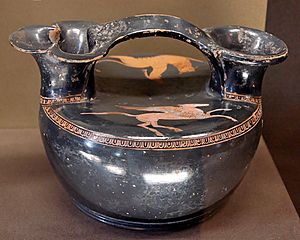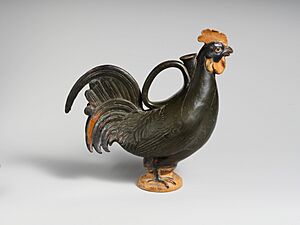Askos (pottery vessel) facts for kids
An askos (pronounced AS-koss) is a special type of ancient Greek pottery. Its name comes from an Ancient Greek word meaning "tube." These unique vessels were designed to pour small amounts of liquids, like valuable oil.
You can easily spot an askos by its flat, often round or oval shape. It usually has a spout at one or both ends, which could also be used as a handle. Just like many other ancient Greek vases, askoi were often beautifully painted with designs. Their main jobs were to store oil and to help refill oil lamps.
Contents
Askos: Ancient Greek Oil Pourers
What is an Askos?
An askos is a small, flat container made from clay. It's different from taller vases because of its low, wide shape. This design made it stable and easy to handle when pouring liquids. The spout allowed people to pour liquids slowly and carefully, which was perfect for expensive oils or perfumes.
Where Were Askos Found?
Askos vessels were very popular and were traded widely across the Mediterranean Sea. This means you can find them in many different places that were once part of ancient trade routes. For example, an askos found in Memphis, Egypt, is now kept at the Petrie Museum of Egyptian Archaeology. This particular askos has a shiny black surface, almost like metal. It was originally made in Ancient Greece, especially in a region called Attica, or in Etruria (an ancient region in what is now Italy). Finding Greek pottery in Egypt shows how much people traded goods in the ancient world.
The Original Meaning of Askos
The original Greek word "askos" actually meant "wineskin." A wineskin was a bag made from animal hide, used to carry wine. While the pottery askos looks very different from a wineskin, it shared the idea of holding and pouring liquids.
See also
 In Spanish: Ascos para niños
In Spanish: Ascos para niños



